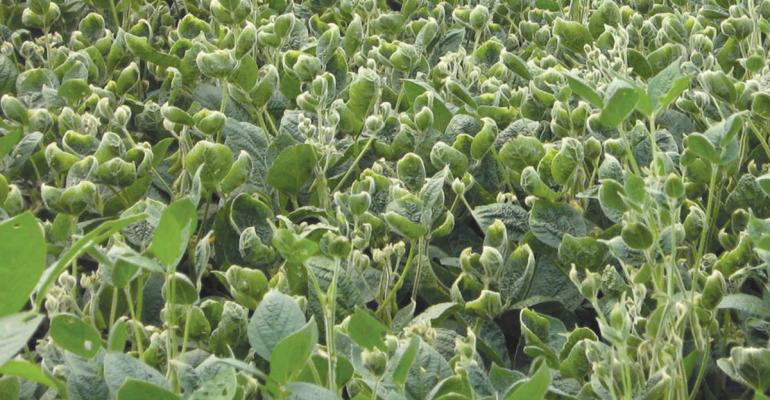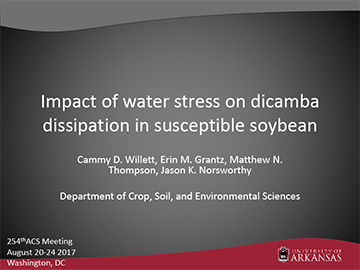Dicamba in Arkansas - Research and FAQs
Weed scientists for the University of Arkansas System Division of Agriculture gave presentations on their research at a field day, Aug. 8, 2017, at the Northeast Research and Extension Center in Keiser. Full-length versions of their presentations are available below. A summary of the field day is also available.
"Impact of water stress on dicamba dissipation in susceptible soybean." Presented to the 254th meeting of the American Chemical Society, Aug. 20-24, 2017.
TIMELINE: What is the situation with dicamba use in Arkansas (2017-2019)?
2017
- June 23, 2017, the Arkansas State Plant Board approved an emergency rule to ban use and sale of dicamba in Arkansas, except for pasture and rangeland.
- June 30, the Governor agreed to have the rule promulgated, sending it to the executive subcommittee of the Arkansas Legislative Council.
- July 5, Executive subcommittee meets. The subcommittee went into recess until July 7 following a meeting that same day of the joint Agriculture, Forestry and Economic Development committee.
- July 7, the Joint Ag Committee recommended approving the proposed ban. That afternoon, the executive subcommittee of the Arkansas Legislative Council voted to take no action. The proposed ban went into effect July 11.
- The emergency rule is in effect for 120 days. The proposed emergency rule exempts use for forage and pastures.
- Aug. 7, Gov. Hutchinson named his appointees for a dicamba task force. The task force held its initial meeting Aug. 17. No decisions were reached, but the task force explored options including a late-spring cutoff for the application of dicamba, added fines for misapplication, and in-person mandatory training for applicators.
- A second task force meeting was held Aug. 24.
- Sept. 7, Monsanto files a petition with the state Plant Board.
- Sept. 12, Pesticide Committee of the State Plant Board votes to accept the task force recommendation to bar in-crop use of dicamba herbicides after April 15.
- Sept. 20, a petition from growers opposing restrictions proposed by dicamba task force is sent to the State Plant Board.
- Sept. 21, Arkansas State Plant Board votes unanimously to back a ban on use of dicamba herbicides from April 16-Oct. 31.The board also votes unanimously to deny a rulemaking petition filed by Monsanto.
- Oct. 19 - Arkansas State Plant Board votes to reject grower-led petition to be able to hear it Nov. 8, schedules subcommittee meeting to evaluate data related to suggestions in petition.
- Oct. 20 - Monsanto sues Arkansas State Plant Board.
- Oct. 23 - Pesticide Committee of the Arkansas State Plant Board discusses points made in grower-led petition, which seeks, among other things, a 1-mile buffer, May 25 cutoff for in-crop use.
- Oct. 27- Motion to recuse filed, case assigned to Pulaski County Circuit Judge Chris Piazza, 2nd Division, 6th Circuit.
- Nov. 8 - Arkansas State Plant Board votes to deny petition seeking disqualification of Terry Fuller. Hears public comments about proposed ban. Votes 10-3 in favor of ban, Fuller recuses from vote.
- Dec. 12 - Arkansas Legislative Council’s Administrative Rules and Regulations Subcommittee on Dec. 12 asked ASPB to consider three separate criteria in any revision of the proposed rule. ASPB was asked to consider scientific-based evidence; a dividing line to create north and south use zones across the Delta; ambient temperature and humidity applicable to temperature inversion during night hours.
2018
- Jan. 3, 2018 - Pesticide committee of the State Plant Board recommended previously proposed rule; plant board votes to accept committee recommendation.
- Jan. 16 - Legislative subcommittee supports State Plant Board recommendations. Goes to Legislative Council on Jan. 19.
- Jan. 19. Legislative Council supports recommendation. The State Plant Board will now file the rule with the Secretary of State’s Office, and the rule will become effective ten days after filing.
- Feb. 16. Pulaski County Circuit Judge Chris Piazza grants motion to dismiss an effort by Monsanto seeking to invalidate the state's ban on in-crop application of dicamba herbicides, citing sovereign immunity.
- June 4. State Plant Board rejects petition to lift ban on in-crop use of dicamba.
- Oct. 31 - EPA extends registration of dicamba for over-the-top use.
- Dec. 6 - Arkansas State Plant Board approves draft regulations for use of dicamba.
2019
- Jan. 7 - First day of 30-day comment period on proposed May 21 cutoff date.
- Jan.10 - 9th U.S. Circuit panel dismisses suit against EPA.
- Feb.5 - Close of 30-day comment period on proposed May 21 cutoff date.
- Feb. 20 - The scheduled public hearing at the Embassy Suites Hotel in Little Rock on proposed cutoff date is being live-streamed.
- Feb. 20 - State Plant Board votes for May 25 cutoff.
- Feb. 27 - New rule filed with Arkansas Secretary of State's office. Will go into effect March 11.
Background on dicamba in Arkansas
- Looking to the future: In the age of herbicide resistance, integrated management is key
- As Arkansas growers struggle with increasingly resistant weeds, state weighs labeling
- Explained: Dicamba and its formulations
Dicamba - Frequently Asked Questions Fact Sheet FSA-2181
- The Division of Agriculture does have a responsibility to attempt diagnose injury where it occurs in crops or livestock. In the case of injury caused by off-target herbicide or other application, our faculty cannot speculate on the source of the injury.
The Arkansas State Plant Board has regulatory authority in this matter and can address questions of that nature. The plant board's dicamba information is available.
Can I use dicamba?
Should I replant?

In deciding whether to replant, growers can make use of the SOYRISK decision making tool, one of several decision tools available for download.
Based on a pair of studies, replanting this late in the season (early July) would potential have a greater yield reduction than keeping an herbicide-injured soybean field.
Is there something I can do to help injured soybeans recover?
There is no miracle cure. The most important point is not to add any more stress to plants that are already stressed. The soybean plants’ ability to recover is related to the growth stage at which it was affected, how many times it received injuries and the severity of the injuries. It’s likely to be worse for soybeans with later planting dates.
